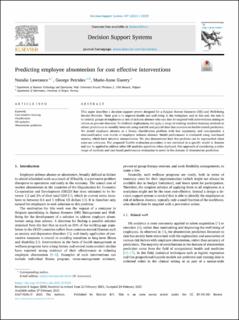Predicting employee absenteeism for cost effective interventions
Journal article, Peer reviewed
Published version

Åpne
Permanent lenke
https://hdl.handle.net/11250/2979882Utgivelsesdato
2021Metadata
Vis full innførselSamlinger
- Department of Informatics [917]
- Registrations from Cristin [9489]
Sammendrag
This paper describes a decision support system designed for a Belgian Human Resource (HR) and Well-Being Service Provider. Their goal is to improve health and well-being in the workplace, and to this end, the task is to identify groups of employees at risk of sickness absence who can then be targeted with interventions aiming to reduce or prevent absences. To facilitate deployment, we apply a range of existing machine-learning methods to obtain predictions at monthly intervals using real HR and payroll data that contains no health-related predictors. We model employee absence as a binary classification problem with loss asymmetry and conceptualise a misclassification cost matrix of employee sickness absence. Model performance is evaluated using cost-based metrics, which have intuitive interpretation. We also demonstrate how this problem can be approached when costs are unknown. The proposed flexible evaluation procedure is not restricted to a specific model or domain and can be applied to address other HR analytics questions when deployed. Our approach of considering a wider range of methods and cost-based performance evaluation is novel in the domain of absenteeism prediction.
